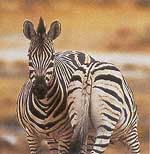PLAINS ZEBRA (a.k.a. Common, Burchell’s, Chapman’s)

How to Recognize
Zebras are common to see. There are two types – Plains and Grey’s. The Plains zebra has a wide stripe which extends onto its belly, and they have an erect, striped mane. This broad alternating black and white stripe is interspersed with faint ‘shadow stripes’. They are famous for their huge migrating herds.
The Grey’s zebras have a white belly and narrow stripes which lack shadow stripes. The stripes form a “bull’s eye” on the rump. They have very large ears, a tan muzzle, and can be found in northern Kenya (we didn't go up there). They are endangered with only 5,000 left.
The stripes are as individual as a fingerprint. There are many theories for their function:
1) the stripes act as anti-predator pattern, making it hard to distinguish a zebra’s outline from a distance; 2) the stripes act as a bonding feature that helps keep herds together; or 3) the stripes are a defiance against biting tsetse flies which can't make out the zebra’s pattern.
Habitat
Plains zebras can be found in savannahs, grasslands, woodlands, and up to altitudes of 15,000 feet. They must be near permanent water, and they avoid wet ground.
Behavior
They are nomadic, traveling to graze on tall grasslands with wildebeest. They rest in the open at night and file to the water at midday. They are highly sociable with other antelopes, especially onyxes, elands, giraffes, and buffaloes.
They are highly intelligent, fast, and adaptable -- they have been seen sliding under wire fences to reach grazing land. They can be found in harems of up to six mares and their foals led by a dominant stallion. These harems are usually grouped together in herds up to several thousand. When the herd moves, the stallions follow behind to discourage predators.
Family members will mutually nibble on each other's legs, shoulders, and necks. Zebras like to roll in the dust or rub against trees or termite mounds which probably dislodges parasites and conditions their coats.
Breeding
Breeding peaks in the rainy season, with one foal being born after a twelve month gestation. They are weaned after six months. Males form bachelor herds and try to abduct females from harems.
Feeding
Zebras are grazers but occasionally browse on leaves and scrub. They prefer tall, coarse grasses not normally consumed by other herbivores.
Enemies
Lions, cheetahs, and hyenas. They will face in opposite directions to help spot predators.
TOP OF PAGE
Copyright © 2002, Dawn M. Dalton.
All rights reserved.
**LINKS**
WHERE?
WHY?
ITINERARY
PLAN YOUR TRIP
GETTING THERE
LONDON
KENYA
UGANDA
SAFETY
ITEMS BOUGHT
STAYING HEALTHY
COMMENTS
HOME
BHS HOME
---Animal Facts--
Baboon
Buffalo
Cheetah
Chimpanzee
Crocodile
Eland
Elephant
Gazelle
Giant Forest Hog
Giraffe
Gorilla
Hippopotamus
Hyena
Hyrax
Impala
Jackal
Lion
Mongoose
Monkey
Ostrich
Rhinoceros
Topi
Uganda Kob
Warthog
Waterbuck
Wildebeest
Zebra